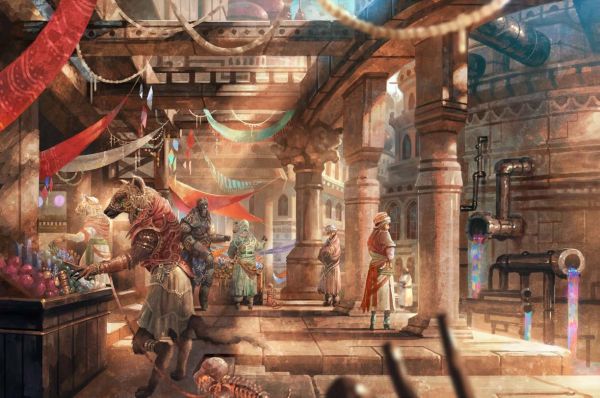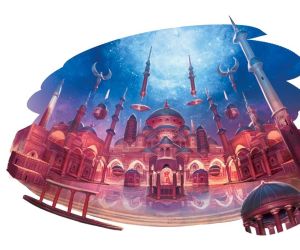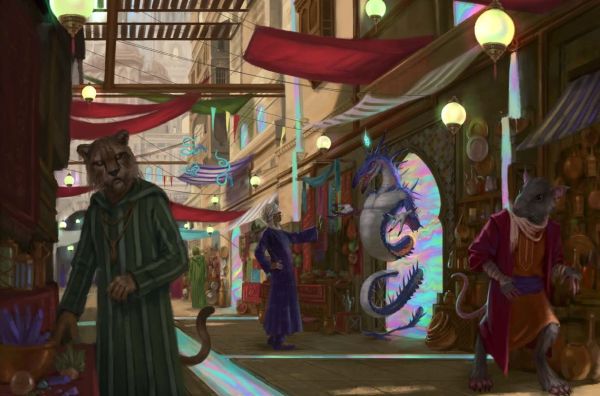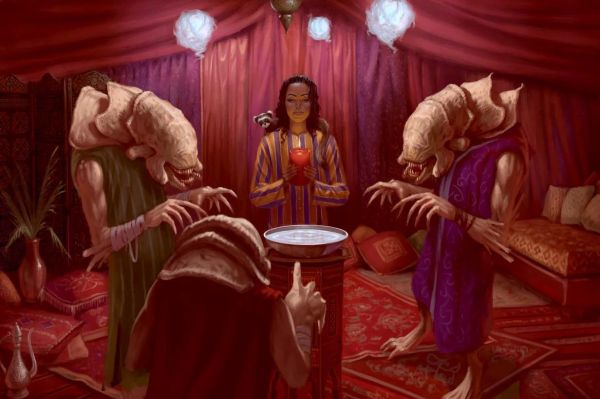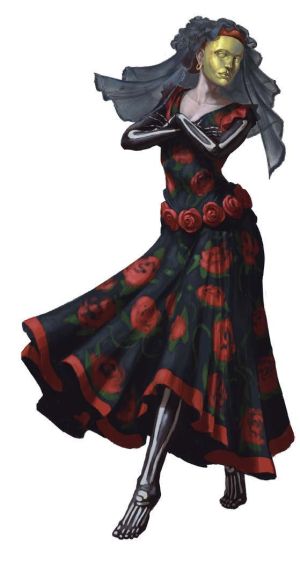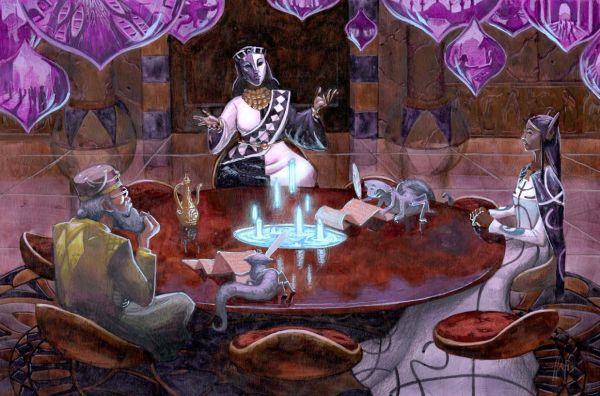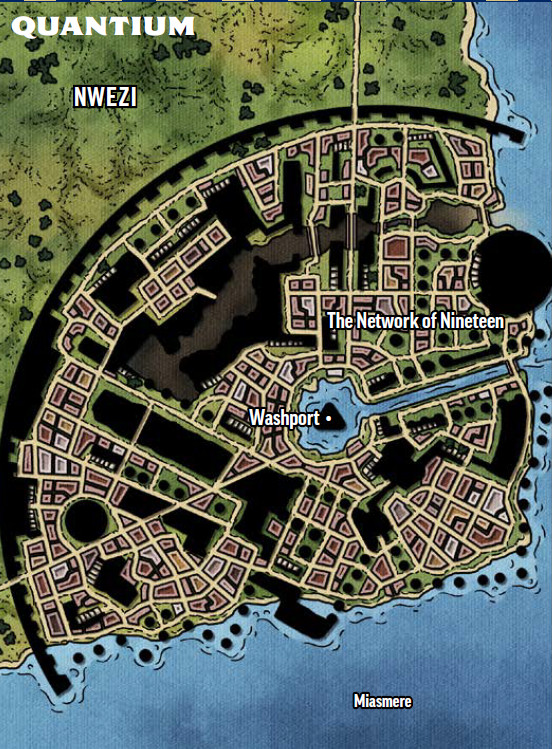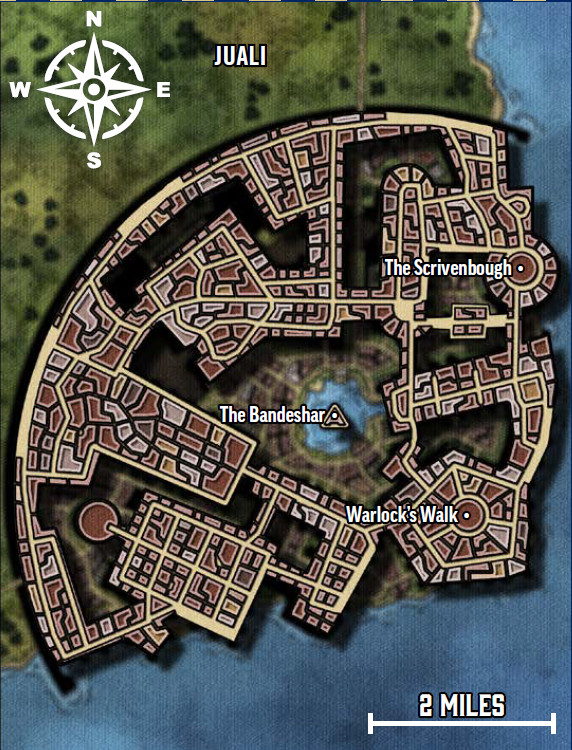« Quantium » : différence entre les versions
Aucun résumé des modifications |
Aucun résumé des modifications |
||
| Ligne 20 : | Ligne 20 : | ||
| population = 60,000 | | population = 60,000 | ||
| demographics = 45% humans, 13% gnomes, 3% catfolk, 2% ratfolk, 2% fleshwarps, 1% ghorans, 34% other) | | demographics = 45% humans, 13% gnomes, 3% catfolk, 2% ratfolk, 2% fleshwarps, 1% ghorans, 34% other) | ||
| langues Kelish, Osiriani, Taldane, Vudrani | | langues = Kelish, Osiriani, Taldane, Vudrani | ||
| religions = Abadar, Abraxas, Calistria, Irori, Mahathallah, Nethys, Norgorber, Pharasma, Sarenrae | | religions = Abadar, Abraxas, Calistria, Irori, Mahathallah, Nethys, Norgorber, Pharasma, Sarenrae | ||
| government = Council | | government = Council | ||
| alignment = [[Neutral]] | | alignment = [[Neutral]] | ||
Version actuelle datée du 24 juin 2024 à 12:34
- Historians claim the archmage who founded Quantium, the capital of the nation of Nex, freely used wish spells to improve the life of its citizens. Though the wizard-king vanished thousands of years ago, his city remains, a masterpiece of marble and magic.
Quantium is a city made to eclipse all others.
Imagine a city of a circular plot, 15 miles in diameter and encircled by a wide “c”-shaped road. Upon the road is set two golems the size of three-story buildings, patrolling back and forth ceaselessly. Both wear the blank countenance of the wizard-king who made them to defend his dream of a city.
| Quantium | |
|---|---|
| Cité | |
| Titres | Monument to Ambition |
| Nation | Nex |
| Region | Impossible Lands |
| Taille | Metropolis |
| Population | 60,000 |
| Langues | Kelish, Osiriani, Taldane, Vudrani |
| Religions | Abadar, Abraxas, Calistria, Irori, Mahathallah, Nethys, Norgorber, Pharasma, Sarenrae |
| Demographies | 45% humans, 13% gnomes, 3% catfolk, 2% ratfolk, 2% fleshwarps, 1% ghorans, 34% other) |
| Gouvernement | Council |
| Alignement | Neutral |
| Dirigeant | Council of Three and Nine |
| PNJs Notables | |
| Iranez of the Orb (N female human witch 20) member of the Council of Three Agrellus Kisk (LE male human arclord 19) leader of the Arclords of Nex Elder Architect Oblosk (LN male kasesh ancient 21) castellan of the Bandeshar | |
| Menaces | |
| troubles civils, intrigues politiques | |
| Qualité Spéciale | |
| Plus rien n'est bizarre : Les habitants de Quantium voient régulièrement des êtres extraplanaires, des voyageurs venus de loin, des constructions, des forgeurs de chair d'Ecanus, des suintants d'Oenopion, et bien d'autres choses encore se promener dans leurs rues. Rien ne les surprend à ce stade. Qu'un personnage soit un monstre ou un membre d'une ascendance, d'un héritage ou d'une classe obscure, les habitants de Quantium ne se laissent pas impressionner et traitent rarement ces personnages différemment d'un humain dans les mêmes circonstances, si ce n'est en respectant le pouvoir de tout être manifestement dangereux. | |
The eastern city terminates at a mile-wide port that lets in water from the Obari Ocean, allowing traders to dock with goods from abroad. Hidden below the waves of the city’s portside lies the mouth of a complex aqueduct running beneath the city and into its heart—a 2-mile-diameter lake. Here, water gets cycled in, through, and out of the city in a similar fashion to the irrigation beneath Quantium’s westward sibling, the city of Oenopion. The grand palace and crown jewel of the capital and nation, known as the Bandeshar, sits with its surrounding campus on a half-mile-wide triangle of an island in the middle of the city lake, elevated 200 feet above the domes and peaks of the highest buildings. No bridges connect this island to the rest of the surrounding city. Any arcane thing could be an entrance to the Bandeshar, but its entrances and exits to and from the rest of the capital are strictly need to know.
The rest of the surrounding metropolis is more than colorful enough to distract anyone who walks through its streets, with its constant hustle and bustle and the variety of people and creatures in its streets. Gathered and curated flora and fauna are sown through the city’s surface and the deep layers that fill its scattered parks and plazas, and the numerous statues, reliefs, mosaics and inscriptions of the wizard-king—and occasionally, his formative cohort as well—decorate every other surface of the capital.
Travelers marvel at the two layers of the wider city. Quantium’s numerous visitors and inhabitants enter the capital from the gates at its north and south rim in their open hours, through the 15-foot, miles-around wall inscribed with illustrations of the nation’s mythic history. The wall fences the visible city in and extends out and over the portside.
Visitors are then met with the first of many staircases leading up to the Juali—Quantium’s “Sun”—or down into the Nwezi, the capital’s “Moon.” These two levels make up the layers of the city. The Juali is partially visible from the treacherous Nexian countryside, constantly circled by the 20-foot Quantium Golems who patrol to and from the Obari shores and who occasionally peer over the wall, placidly checking the city of their charge. The Nwezi lies beneath the Juali, lit up with unusually hued arcane lights throwing dazzling colors from their glass sconces where visitors descend. Purposeful, circular gaps in the Juali expose the neighborhoods below to the natural light, and the complex, beautiful architecture built in the Nwezi below support the equally impressive city blocks above. Both are connected by patterned pillars, buildings, supports, and archways, and the deeper city is run through with canals and pipelines that make for small cascades and waterfalls from its aqueducts. All of it is hewn from handsome marble, precious minerals, jewels of floral hues, and elaborately shaped glass in colors to match.
Quantium is the perfect metropolitan representation of a man who disappeared into himself. As the capital city of Nex, the utopia the country’s namesake imagined is metaphorically following his suit. This city, spun of cadres, circles, and coteries, lit up with magic and glued together with a lifetime’s worth of wishes, is threatening to collapse under its figurative weight like the rest of the nation. The water that churns from the ocean into the city near the ports is more toxic than the Bath in Oenopion, thanks to the pollution Quantium’s citizenry bleed into it with abandon during their day-to-day. The consequential Miasmere bay, which churns in and out of the city, has none of the Bath’s sentient wisdom and twice its threat. All the splendor of Nex can’t hide the stain of Quantium’s collective ego.
The capital is a beautiful thing—and beauty hewn of ego is the most fragile sort.[1]
A DAY IN QUANTIUM
Without any sort of timepiece, the days blur together in Quantium’s sprawl. Its arcane hustle and bustle is ever fueled by intrepid minds that cast any normal sleeping schedule to the streets while they look to the stars, shadows, and beyond for deeper and deeper mysteries. Lanterns of all sorts of unnatural color stay lit day in and day out. The luminous white marble of the main streets and many of the official buildings of Quantium refract the lights’ dizzying array of prisma into the sky, to a degree that its true color is often blotted out. From the city streets the sun often looks like another star, and the stars simply melt into the luminous atmosphere. Only the moon makes any kind of consistent appearance in the city’s view of the sky. The people below are far too wrapped up in their day-to-day to take notice.
The unexpected is almost commonplace to a destabilizing degree for visitors and travelers uninitiated to Quantium’s arcane, plane-spanning metropolis. One might share freshly brewed qahwa with a dweomercat in a café at morning, then barter for extraplanar materials to study with a glass golem tending its master’s component salon in the afternoon in one of the Nwezi’s many strange bazaars. Next, one might spend the evening reading inside a living library more than happy to share incisive opinions on its visitor’s taste. Around each turn, the capital buzzes with idiosyncratic activity, overwhelming those within its latticed belly with new stimuli and information. Magic isn’t rote here, but it’s pervasive enough in every aspect of the city’s construction that the locals almost have to blot it out of their registry to function.
Living in Quantium by coin alone is too expensive for most to weather without familial wealth and status in and beyond the nation. Consequently, Quantium is aggressively stratified, but many locals try to hustle through the material struggle dealt to them to enjoy the city’s arcane treasures. The average local lives and breathes their work, a perfect distraction from the city’s lack of significant civil support. Domestic tenure in Quantium is ephemeral unless a person is materially thriving or suffering—and the commotion of the city obscures the latter until it’s too late.
In truth, a good amount of Quantium’s civilian traffic is rather transient. Some are knowingly so, and have taken to the streets of the deep city to try to redefine the dynamic between “owner” and “owned” of property in Quantium, in protest of its elite’s neglect. Many are impermanent by consequence of a scenic visit or esoteric personal business. They enter its walls one day, leaving overstimulated but full of colorfully sacred (and profane) anecdotes in the next. More than a few use Quantium as their momentary door into and out of the Material Plane.
Much of Quantium’s busiest activity happens within the Nwezi. The day disappears in its elaborately layered smear of arcane lights, beautifully ornate doorways, askew warrens, festive alleys, and constant crowds full of denizens mundane and magical—all backed with the most gorgeously alien music one could imagine physical instruments forging. It easily makes up two-thirds of the capitol’s infrastructural density, and four-fifths of its stable populace. The Nwezi is a dense, artful urban labyrinth of people trying to get each other’s attention, selling their way up the chain to escape the sensory overload within the city’s midst.
The polluted water from the Miasmere cycling endlessly into and out of the capitol lends the entire Nwezi a chemical scent that stings the nostrils, similar to the scent of ozone and a pinewood or maple tree fried by lighting. When Quantium’s lake and aqueducts aren’t running into the local’s homes, interiors smell better, often helped by Oenopional aromas or floral candles. The Nwezi quakes considerably to the shake of each of the great golem’s footfalls outside of the city—though the architecture rarely rubbles and never collapses from this. Still, the metronome-like sound is enough to drive those living under it to the surface just to think. The novel beauty of a brief visit can become a nightmarish daily life under Quantium’s Sun.
Many try to climb their way up to the Juali through their daily trade and grift, but more often, in recent years, there have been protests bubbling up from within Quantium’s urban depths. The past decade has seen the city’s most frustrated, exploited, or neglected increase their displays of unrest to a near-daily occurrence, cutting through the Juali’s calm and clarity. Otherwise, the Juali is serene and pretty, with the sharp ozone smell below dissipating as the scent drifts through the windows to the open air. The heavy thud of the golems that quakes the Nwezi is a soft, soundless bounce in the Juali above; the heavy metronome is a handily ticking clock up there.
The discontent is starting to stick more above the surface in Quantium. The folk in the outer city above or below often cast their eyes to the Bandeshar as it sits largely undisturbed by the quakes of the wider city’s ramshackle bustle. A few manage to wonder, in between their distraction, what could be so important within the palace to keep it so segregated from the city it’s the center of. Yet the days of those who make it there are somehow more ill at ease in the palace’s contrasting placidity. Many can feel the tension within the palace they’re privileged to work within—can feel Nex’s disappointed gaze more in the campus around the palace than when his marble imitations stare at them from four different vantages in an underground Nwezi grotto.
Those who have worked hard enough to earn a position in the Bandeshar are also offered lodging to accommodate them. They rarely make the move.<ref name="a"/ >
A YEAR IN QUANTIUM
Much happens in the Quantium year. For those who can find a way to cut through the city’s distractions—or find music in the noise—Nex’s capital city offers a wonderful refuge to shape themselves in. A year in Quantium can be so relentlessly busy that it resembles a month to locals, while a traveling neonate spending a month in the city might feel like they have aged a year from the amount of information they’re exposed to.
Of the cities within Nex, Quantium is the most inviting to the outside weather and elements. Most days in both the warmer or cooler seasons are pleasantly sun-kissed—but since Quantium is a coastal city, it garners its fair share of prismatic storms and occasionally acidic rain in the course of a month, rather than falling into the more generalized dry and rainy months the region subjects the rest of the nation to. The city’s plan openly welcomes the elements from the coast, and the magic that swirls in the Obari Ocean that’s leached in from the Miasmere’s pollution often catalyzes arcane storms that brew to considerable size. The city’s magical protections largely keep the sometimes-cursed rainfalls to negligible impact on the architecture and negligible discomfort for the city’s inhabitants. After a year it goes unnoticed, or one learns to wear an enchanted hat or hood with a wide cover.
While torrential downpours and thunderous crashes do nothing to threaten the complex marble lattice of the city, these coastal storms are still a rather startling monthly occurrence. Though they’re beautiful to see from the Juali, being within the Nwezi is more of a roulette. The pouring water that cascades down steps and through complex networks of aqueducts through the two layers of the city can be a joy to listen to and watch—but thunder reverberates to a deafening volume in the Nwezi. The wet months of Rova to Calistril only increase the frequency of these storms.
The city’s inhabitants commonly use three calendars. The first is Golarion’s standard metric, acknowledged more for the sake of travelers coming into the city than any other reason. That said, Quantium is quite internationally tinged, and it is also deeply festive, so the city holds many holiday celebrations—though they are frequently reduced from their religious and historical context in favor of the celebration itself and its accompanying aesthetics. More generalized holidays that are re-interpretable or centered around revelry for revelry’s sake enjoy the most enthusiastic celebration. Holidays that engage with matters of the dead see a tension run through the city, though private celebrations in the Nwezi provide the rare culturally scandalous thrill. A theatrical interpretation of the Day of Bones is the embraced exception because of Pharasma’s prominent clerical presence in the city, though real corpses are swapped with elaborate props and costumes to exalt the dearly departed.
The second calendar that finds common use in Quantium is the exchange calendar. This calendar is used by the capitol’s entrepreneurs—particularly the ones who live in the Nwezi near the port side of town. The exchange calendar is 369 days—four days longer than the common calendar detailed above. Its segments are planned around the Network of Nineteen’s opening (page 264) because of the amount of unique goods and clientele that come from outside of the Material Plane to shop during these days, not to mention the people who choose to land at port to peddle their wares. What results is a calendar of 19 segments, each of 19 days. Often, one of these periods of time is a rest period roughly aligning with the end of the region’s wet season, and the other 18 segments through the year are split between selling locally or traveling through the doorways in the Network of Nineteen.
Finally, the Bandeshar and those under its employ use a calendar devised by the Council of Three and Nine, which is planned across an almost-standard 365-day year but is mapped to the fortnight rather than to the approximate month. The first day of each of these two-week periods is marked by a meeting of the Council of Three and Nine, assessing the city and wider nation. The seventh day of each fortnight marks a private meeting between the Three, which is documented by one of the Nine (typically Pharasma’s High Cleric). The 14th day of these cycles is a rest day. Between those three markers, it is assumed that those who tend obligations within the Bandeshar are exceptional enough individuals to autonomously pursue bureaucratic matters of city, state, and beyond.
The Arclords of Nex claim that this method of scheduling is the same that Nex used in his early days of conceiving the nation, and in times of great stress he would use this two-week format to re-center himself through a formidable focus, accomplishing a great feat by the end of this rigor and taking a full day to indulge in and marvel at his accomplishment. The odd day of this calendar is actually the last of the year, Invigoration Day, in which Nex and his followers would go to a place completely new to them with the express purpose of enjoying themselves in an unprecedented sensory excursion. There they would unravel the further mysteries of existence in—as the Elder Architect describes—an “occasionally hedonistic” way. His explained purpose, according to some of the wizard-king’s few published notes, was to carry an invigorated verve into the new year of invention and ambition. Since his vanishing, it has become Introspection Day, a day many locals of notable repute observe, as they fast in memory of their wizard-king and in contemplation of themselves.
all work and no play
Rumors persist that students at the city’s Seven Veils magic academy have learned a trick for making simple illusory images of themselves independent, allowing themselves to form study groups with magical copies of themselves. Sometimes students who attempt this return intrinsically different, fixated on solving their issues through any means necessary. Despite several notable incidents, Schoolmaster Denungar Neev has so far prevented any investigation into the matter.<ref name="a"/ >
PEOPLE OF QUANTIUM
Quantium’s citizenry is anything but expected. The city overflows with oddities that walk its streets. Ghorans spread their seeds in preparation of their next life. Constructs walk around with a consciousness or two stuffed into their body. Catfolk and ratfolk chase each other in the warrens of the Nwezi. Fleshwarps and mutants from the countryside lobby for provisions to their clans and circles. Disgraced devils and demons run quaint businesses selling secrets and sorceries. Changelings search for purpose in a city they understand as a font for it. To top it off, Quantium’s definition of “pet” might melt the minds of residents
in most other places. If it’s strange somewhere else and can fit in the capital streets, one will meet it here—so long as it isn’t undead. The determinate net of the word “people” in Nex’s capitol carries a dizzyingly wide definition. It demands its visitors to expect, and accept, the alien.
The more internationally common ancestries within Quantium’s citizenry rest upon a considerable human minority of heavily Garundi, Keleshite, and some Vudrani backgrounds. Some of the eldest and wealthiest of the Keleshite diaspora have significant representation within Quantium’s walls. A healthy number of locals of Bonuwat and Bekyar descent immigrate from the Mwangi Expanse. In a city full of accomplished arcanists, sorcerers and wizards, some of the most impressive mages the city welcomes unsurprisingly hail from Nantambu, though the city’s wanton nature rarely agrees with the Mwangi scholars’ more egalitarian dispositions. Often, their presence is a temporary, academic one in official terms—usually a sign that the Magaambya is investigating some arcane Nexian malaise or is there by Bandesharite request. Distant and unusual genetic unions in the history of this plane-crossed city’s elite see many families of significance living within the Juali who superficially register as human but are revealed as various varieties of tiefling or aasimar descent with closer inspection.
Another notable minority that fills Quantium is the Keenspark gnome population. Their numbers have blossomed in the last millennium because of the diverse selection of arcane and mundane materials acquirable within the city walls, which act as a magnet for their technical curiosity. Their particular and iconoclastic nature largely agrees with most of Quantium’s intrepid self-made fleshwarped—but the veneration of Nex in the city often sees their stereotypically precarious disposition sour. Even with this thinly veiled distaste for the wizard-king’s cult, Keenspark arcanists find fast success in the city, often staying in the subterranean matrix of the Nwezi to study for themselves in urban hermitage.
By contrast to humans, planetouched, and gnomes’ prominence, halflings, dwarves, orcs, and especially elves tend to be somewhat sparse in the capital, preferring the quieter demeanor of Oenopion—though elves are even rarer residents in Oenopion than anywhere else within the nation’s cities. The infrequent representatives of these ancestries residing in Quantium are usually of Avistani or Casmar origin rather than of Garundi background. The Mualijae-descended elves from the Mwangi Expanse find the whole of Nex, especially Quantium, a distastefully wanton place, often only setting foot in the city with specific, reluctant intent. They share this reluctance with mutants of the countryside and Mana Wastes, who are often ignored or overlooked when their physical appearance is too “distracting,” or their demands are too loud—an absurd claim in such a strange city. The outsiders who are sometimes part of these wayward clans find far more success in procuring support from the government, though this struggle is far less an issue for the Manymen mutants (page 248) due to their official representation within the Nine.
Djinni are of pervasive, if not prominent, presence, having helped construct the city by Nex’s wish and will. In tandem with the Elder Architect’s work, they are likely the reason the capital hasn’t capsized to its ancient infrastructural impossibilities. They inhabit the elements of the city, pulling wishes when they want to from Quantium’s numerous desperate. Some do take on a more pedestrian tact in their navigation of the city—and a more carnal exploration of its social circles. Consequently, there is a notable selection of geniekin in the city, many of whom carry blood relation to Quantium’s aristocracy.
Nexus House
Founded by the Pathfinder Adolphus and the radical Bhopanese princess Ganjay, Nexus House is the second-oldest and second-grandest Pathfinder Society lodge. Luxurious and gorgeous, Nexus House hosts a regular series of lectures, garden parties, and other gatherings—most of these events are decades or even centuries old and are woven into the social tapestry of Quantium. Recently, however, creatures from the Spellscar Desert in the Mana Wastes have been targeting Pathfinders, leaving the current vash-vatom increasingly worried. For more information on Nexus House, see page 94 of Pathfinder Lost Omens: Pathfinder Society Guide.<ref name="a"/ >
Factions de Quantium
Quantium possesses a somewhat formal social hierarchy guided predominantly by the families who have inhabited the city the longest—and the Council of Three and Nine—in the wake of Nex’s disappearance: in order of most to least influential, the Bandesharite, the Populasi and Rastrashi, and the Galisite. Though nowhere near comprehensive, the following are some of the most notable groups and factions across the capitol’s social strata.
The Bandesharite: The well-known and reluctantly well-regarded rulers and delegators of the city (by design) and nation (in practice), having forged and maintained longstanding institutional power. A Bandesharite’s votes and words are often the ripples that evolve into the norms of Quantium for the next century, and as such those of this group spend the majority of their time going to and from the great palace of the class’s namesake. The individual members of the Council of Three define the parameters of this space. Some of these individuals have pulled their associated social families up with them—like Praavi Skriiphuveti’s work in establishing the Merchant’s League of Nex. Others have kept their factions at a visible distance to attempt to shield their street-level machinations from the scrutiny of their colleagues. Gen Hendrikan (page 259) is a sterling example of one such personality who’s been keen to maintain public separation with the Keepers of Abraxas.
Her Most Keen Eye: Councilor Iranez’s network of spies and informants, who seek out plots against the nation. Her most immediate concern (which some within the Council would consider oversight) centers the Evisceration of Ecanus rather than the capital itself. In a city where the citizens are on average in three places at once, Iranez’s agents take this tenfold, and she herself one hundred. If they wish to be identified, officials of the Eye—often called the Keen—wrap their heads in turbans in a way that covers their eyes like a half mask with no eye holes. The fabric matches the color of their dark, tailored djyllab, the suits often embroidered with patterns of eyes that are visible only upon close inspection. When investigating, the Keen opt to make themselves completely discreet.
Her Most Keen Eye has the most direct, official ties to Nex’s military in Ecanus. One of their main fronts in the city are His Future Witnesses: skilled artists and artisans who decorate the city with surveillance tools for the Keen, often with iconography of Nex and the mythology surrounding him.
The Breath: The most prominent organization of assassins in Nex, organized by Master Phade (NE male invisible stalker), a member of the Nine. Their operation is rarely personally or economically motivated—such pettiness is left to hedge murderers of Galisite quality. Instead, the Breath are interested in whose words balance the city and state, and whose whispers must be silenced before hampering it. For most outsiders, members are supremely hard to discern unless one is made in the know (or is about to meet one’s fate), often because they keep their dress and cover within agreeable guises, or in rarer cases are literally invisible. A cautious friction has evolved over the past 500 years into a fruitful alliance between Iranez’s keen eye and Phade’s keen blade.
Quantium’s Wish: Something of an anomaly amidst the Bandesharite, Quantium’s Wish is a semi-formalized union of the djinni and aristocratic families run by geniekin in the capital. They occupy this station because of their ancient collaborations with both Nex and Oblosk in realizing Quantium and are instrumental in maintaining the city’s construction in the current age. Because of this, this group is one of the networks of entities with a knowledge of the city’s geography approaching—if not quite equaling—the Elder Architect’s.
The Arclords of Nex: Under Agrellus Kisk’s guidance, the internally conflicted Arclords of Nex are the most overtly propulsive faction across the nation, claiming to know and represent the wizard-king’s vision best of anyone by guidance of his journals, protected and passed down between countless generations of his servants and their descendants. The Evisceration in Ecanus has earned back some needed goodwill for the Arclords after a millennium of their warmongering without justification started to wear on Nex’s citizenry. Members of the Arclords can usually be identified by their (often closed) third eye. The group takes some petty umbrage with Her Most Keen Eye for what they see as a purloined motif—and actual frustration with Iranez’s political disagreements regarding war. To contest the Keen’s authority of national security, the Arclords cling to a rough-hewn station as enforcers of Quantium’s nebulously defined laws and norms in the capital streets.
The Populasi and Rastrashi: The common glue of Quantium, which most forget are necessary for the city’s function and thriving. The Populasi, or “popular interest” of the capital, are the citizens of Quantium of enough wealth, reputation, and energy to lobby for what they see as necessary political measures. What they lack in political push they make up for in community sway and threat—and the Bandesharite are keenly aware of the consequence of crossing groups and individuals who lie within this class. The Rastrashi, or everyday people, are often the most underestimated in their importance to Nex and Quantium’s financial health. Much of this perception likely comes to this designation referring to the average citizen of Quantium—insomuch as anyone can pretend there is a particular standard—and their transient visitors. It’s often overlooked that the cash flow that moves through the city and region from elsewhere keeps the international affairs of Nex’s elite afloat. These are common folks with no larger enterprises of any notability, though some make the transition from passive citizen to engaged occupant and find the threads they’ve stitched in their time in the city comprise a quilt that casts a large shadow. To this end, one may say the difference between the Populasi and Rastrashi comes down to how much one cares about flouting one’s status rather than wielding it.
The Merchant’s League of Nex: This collaborative group organizes the trade of any major commercial entities operating through the nation, giving license to their trade if they have a storefront or transaction site across the nation, imparting taxes if a certain amount of income is earned, and enforcing and settling disputes and unreconciled barter after each season. Because of this diplomacy, high ranking Vendra of the Merchant’s League often serve as civic judges for the wider city—a point of umbrage and threat from Agrellus Kisk and the rest of the Arclords of Nex. Much of this business is officiated outside of the Bandeshar no matter where in the nation it starts, despite the League’s main advocate, Paavi Roh Kenavrii (N female tiefling human barrister), occupying one of the seats of the Nine. Officials of the League wear tailored achkan in simple colors or creamy white. Higher-ranking officials bear handsome sherwani patterned in gold. The Galisite: Every angel battles their demons, every light is sculpted by its shadows, and every city street is connected by its alleys. The Galisite, or alley people, are the perceived beckoners of Quantium’s dark side. Few things are marked as illicit in a city with such apocalyptically renaissance verve as Nex’s capitol, but the Galisite are understood to deal in illicit intent, larceny, murder, trafficking, and other nefarious crimes, with the notion that they fill the alleys with most of the city’s unnaturally dead—and invite them to rise again. In public forums, the groups shoehorned into their ranks are decried and persecuted for their services, but if the ambitions that moved Quantium to action were made more transparent, almost all from top to bottom would be this class. Coming to this realization, the Galisite purveyors of Quantium have often managed to weave their own considerable tapestries of influence and power through the entire strata of the capital. If they aren’t misunderstood or punitively stereotyped, they’re savvy enough to keep in mind that everyone has a bad day and a worse side and because of this, terrible business will always be good and abundant.
Passages of Nex: The most mysterious influences in Nex are various people who resemble slain enemies and victims of the wizard-king himself, who claim to speak for the absent ruler. These individuals are hunted by the Bandesharite, yet find surprisingly dogmatic exultation in the wider citizenry’s talk. They often migrate from the Well of Lies across the country, but more recently have emerged from doorways leading to the Refuge of Nex—which those most in the know take as a harbinger of Nex’s return. The Passages agree, but state that his return will be the end of his nation. The Keepers of Abraxas: Those who act as the librarians of ruinous secrets and are servants of the Demon Lord Abraxas—knowingly or otherwise. Gen Hendrikan (CE male human priest of Abraxas), chief Keeper and Cleric of Abraxas, often posits that Nex himself was the second Librarian of Abraxas, implicating that many of the wonders gluing the capitol together are in fact edges of the Final Incantation the demon lord himself imparted on the great wizard. Today, the Keepers tattoo each other with their lord’s arcane secrets, with certain members being almost exclusively indigo with esoteric ink shrouding their skin.
Scepter of the Arclords
An unfinished artifact constructed by Nex, this magical scepter was claimed by the Arclords after the archmage’s disappearance. Renamed the Scepter of the Arclords, the large rod aided the Arclords in their rise to power in Nex and followed them to their exile in Jalmeray. It was the scepter that enabled one of the greatest crimes in Nex’s history, obliterating the Sunghari people living on Kaina Katakka and reducing much of the island to ash. The Arclords sequestered the scepter in a remote stretch of jungle afterward, and then lost access to it when they were expelled from Jalmeray. With rising fears of war approaching, some among Quantium’s elite now scheme ways they might get the artifact back.
A Skilled Haggler
There are downsides to Quantium’s remarkable tolerance, and while Her Most Keen Eye and the Breath keep wary eye on dangerous visitors, they can often be bribed to let well enough be. Aslynn, an infamous night hag who has made enemies of the Pathfinder Society and sorceress Hao Jin among others, has been a known buyer and trader of magic in Quantium for nearly a century. The hag has never been connected to a magical incident and has been quick to provide gifts of rare magic to local officials, and so her presence has become well established.<ref name="a"/ >
CULTURE
Quantium is the most picturesque city in Nex, and its beauty attracts and inspires creation of all sorts, whether that be art, music, writing, or most frequently, magical exploration. The city of Nex’s dreams taught the rest of its inhabitants that they could make their own fantasies a reality. Here, the sacred and profane overlap fiercely, the personal and public blur dangerously, and the obliteration of these boundaries that pervade other, less ambitious cities instead opens doors to something that the wizard-king himself would see as a divine challenge. Find—no, make oneself in the adventures of the arcane: that is Quantium’s charge to all who set foot in it.
The second binary is far clearer cut—that of the dead, and the undead. Should someone be rendered dead in the city, as is true through the rest of Nex, they are also quickly made gone in body and spirit so as to never rise again. A proper death in Quantium leaves behind only a memory, and any dead thing rising again prompts suspicions of Gebbite subterfuge. Finding a decomposing body of anything larger than a house cat in the city once spurned Quantium’s citizenry to request the services of Ecanusi Deathsealers with such frequency that they eventually were stationed within the city at several specially built disposal facilities, now known as Crossings.
Because of Quantium’s competitive and often agitated local politics, a thriving lifestyle in the city is one best assured through a reliable web of association and renown. The locals know this, and they have centered their culture around the actualization of ego. Outside of Nex himself, one’s own being is the most sacred—and such vanity is rarely discouraged among the most powerful residing in the city, when paired with bold ambition and bright aptitude. Attention isn’t inherently good or bad in Nex’s capitol, but it catalyzes whatever web its subject is spinning. Whether they find themselves tangled in their own net or ensnaring their quarry depends on how they use their persona. It’s wise to find one’s mask in Quantium, and only take it off around those one trusts. Through this social game, Quantium’s culture often leads to the creation of various cults of personality from the most voracious egos within the capital. With near as much regularity, the frictions and full-blown conflicts that vibrate through Quantium’s streets see many others possessing weaker wills and murkier visions fall into an actual cult behind them, though the larger groups would rarely admit to it. The city is a den of cadres, circles, and coteries. For all the voracious pursuit of individual dreams, Quantium’s inhabitants find their stability in subscribing to one of its countless factions, whether large or small. With a well-enough-calibrated guise, the most adroit of the capital’s ranks may even forge support for themselves through multiple groups. The most reliable currency under the capital’s social makeup isn’t gold but bartered favors. Expect to pay this way with anything more than rote and think of it as investing in the account of one’s reputation.
Even if Nex was vain, he was—and to the nation’s knowledge, remains—powerful. That power inspires respect and fear in tidelike turns. It’s hard for such a thing not to, with every third person vying to announce their distant ties to the wizard, every second door being decorated with inscrutably romanticized abstractions of his face, and every building being watched over by a larger-than-life statue of him. The pervasive message of the city is simple: be yourself, like Nex was.
With such a focus on the prowess of the self, faith often trends toward gods who preach a means rather than an end. Nethys is as close to a national religion as can be found, without the dictates of the state officially decreeing it. On the darker side of the coin, both Abraxas and Mahathallah find prominent public adherents, though the cruel truths of Mahathallah are somewhat more acceptable than the cutthroat ruthlessness demanded from the demon lord of magic. Irori, with his focus on personal improvement, also finds a popular following among Nex’s nigh-solipsist elite. Among the lower echelons of society, fleshforgers and those who seek to mutate themselves turn to Lamashtu, asking her to guide them toward new and glorious forms. Calistria’s passions and lust for life guide many a Nexian on a path of glorified personal appetite. There are exceptions to this rule, where even the most jaded of residents will put aside their personal aspirations and pay their respects to a higher power. Sarenrae’s kindly tenets might be looked down upon by the more world weary, but her prowess against the undead is not, and no one in Quantium dares publicly blaspheme the good name of the Lady of Graves.
The food in Quantium, at least in restaurants and sit-down spots, is beautiful to behold. The flavors, especially in comparison to the pace set in Oenopion, is less reliably impressive. A large reason for this is the quality of ingredients that come into the city. In theory, seafood is a prominent staple in the capitol due to it being a port city, and the mutated and transformed sea life make for wondrous presentations—and often acquired tastes, although the street food in the Nwezi is a more reliable source of joy for locals than the sit-down eateries in the Juali. Ghoran is even more scarce an ingredient because of the more niche populace than in Oenopion, as there are fewer plantfolk who reseed and offer their discarded body for consumption than in Quantium’s alchemical sibling. There are some specialty chefs who are willing to take on extremely exclusive and expensive dishes for private clients—if a person has ever wanted to eat young umbral dragon, someone here can prepare it and keep the shadow in its blood from suffocating the diner. Just expect a steep price for the service, as the chef likely hunted down the entrée themselves.
The garishness and resplendence of this attitude extends to the aesthetic of the city. Like the colorful, layered, precisely fashioned, and artful architecture of the buildings that wind through—and sometimes, in the Juali, float over—the city streets, the fashions of Quantium’s citizenry carry a similarly dramatic flair. One is bound to see many styles of clothing on the street because of the amount of foot traffic the city attracts, from not only the rest of Nex or Garund but the globe and other planes. Those who choose to live in the city, however, tend to adopt some common hallmarks of Quantium fashion.
Most common of fashions in the capitol is the genderless djyllab as a standard piece for most who wander the streets in a more-or-less humanoid frame. It is a somewhat loose-fitting robe that typically terminates at just around the ankles and slips over one’s head. Often the djyllab is hooded and is worn over other clothing—though a common jape at galas and soirees held by confident socialites is for the host to wear nothing underneath. For some beings, the djyllab is adorned with secrets; spells are embroidered around the neckline and down the front and back or stitched into the seams connecting the robe’s arms to its plunging middle. Whether robes, coats, vests, or cloaks, one can tell a Quantium garment by its embellishments and decorations, and these details are almost always enchanted as well. It’s appropriate fashion for a city whose people have almost as much to hide as they are keen to show.
Mahathallah
One of the Queens of the Night, Mahathallah and her followers meditate on the mysteries of the cosmos and seek out fate-changing knowledge. They are known to cruelly veil or reveal the truth at their own whims, though they typically view themselves as above others. Due to Mahathallah’s allegiance to Hell, her worship is discouraged in most nations, but the people of Nex welcome the insights of her clergy.
Preserved Lemons
Salted lemons imported from Katapesh make a strong addition to many Quantium dishes and help cover some of the aftertastes caused by magical pollution. The following recipe can be used to create preserved lemons to add a sharp, but not overpowering, element to a meal.
Ingredients
Lemons
Salt
Quarter and seed whole lemons. Cover the bottom of a large glass jar with salt. Press the lemon quarters firmly into the jar to create a layer of fruit, then cover them with another layer of salt. Repeat until the jar is full, ending with a layer of salt. Leave the jar in the pantry for one month before using.<ref name="a"/ >
GOVERNMENT
The Council of Three and Nine, established in 578 ar, is the ruling government body holding Nex together through internal contention as much as it is through collaboration. It defines the nation but is shaped by bureaucracy and its own members’ stratagems—frequently as self-serving as they are in service to Nex’s whole. The Nine are representatives of various significant entities who are the movers and shakers of the arcane machine Nex has become. Two- thirds of the currently composed Nine live within Quantium, though they and their affiliated groups by proxy presume to represent the entire nation. Their seats are in hot contest, and nomination to the Nine is subject to the explicit discretion of the Three.
In stark contrast to the Nine, the Three of the Council take a more stable role in Nex’s composition—serving their tenure until either confirmed death, resignation, or otherwise comparable incapability to rule. While the Nine can voraciously lobby for their issues and concerns to the Three, the former’s station is ultimately to perform the tasks delegated to them by the latter. The Three are the true final word in Nex, and any contentious decision that comes to a vote for the nation’s fate is kept within their own private rapport, with the results announced by Bralza (N female elf priest), the High Cleric of Pharasma and the most reliably impartial of the Nine. This impartiality, combined with her attentiveness to all exchanges of the Council within the Bandeshar, has made her the unofficial speaker of the nation.
To deal with each other and massage the nation into the shape they think is best, the Three attempt to disguise their own agendas through clandestine politic and leveraging different aspects of their subordinates and national charge against each other. In theory, they embody the continuing word and intent of Nex, but this goal is only reality in stops and starts. In any age of Nex’s history, at least two of the elected Three work predominantly from their own ambition, and often the Nine become reluctant proxies of their agendas. The people of Quantium and the wider nation have acclimated to what appears as inaction as a result, despite the amount that truly happens behind closed doors to continue changing—without improving—Nex.
The Council has kept the shape of its concept from some four millennia ago, but the details are less stable. To the outsider, the most consistent aspect of Nex’s ruling body in the last two centuries are the aforementioned Three. The first is Elder Architect Oblosk, the famed castellan of the Bandeshar and chief author of Quantium’s major architectural identity, besides Nex himself. Next is Iranez of the Orb, who serves as the prime and divinatory eyes and ears of the city and its larger state. Finally, the ambitious Agrellus Kisk, the preeminent member of the Arclords of Nex who seeks to revive the ancient war with Geb as he and his fellow Arclords surmise the wizard-king would have intended—they see the tenuous mercantile relationship slowly forged over the last two millennia as an egregious affront to Nex’s wishes. The present Nine have largely stayed stable for the greater part of this present decade. The master alchemist and prime fleshforger’s seats have nary been in question, nor have those of Gen Hendrikan, Master Phade, and the High Clerics of both Nethys and Pharasma. This is perhaps because this current body works as a more direct means to guide the nation than the Three contending with each other.
In function, council meetings yield to more violently shifting sands when held under the glass for examination. Iranez of the Orb has long massaged the nation toward more and more functional and regular trade with Nex’s once-dire rival Geb from her seat of supremacy amid the Three. She has often found support from the Elder Architect in the last millennium for forging true stability in a new age for a city and nation that will never see its progenitor’s return. Agrellus Kisk has been near-universally outvoted in his comparably slight 100-year tenure during council meetings in the Bandeshar, and he’s turned to abusing the Nine to his own ends. He, as well as most of the Arclords of Nex, have wanted to reawaken the arcane war once waged against Geb. The past 5 years have seen the Arclord more vocal about his and his fellow Arclords’ self-righteously bloody ambitions in both the largely apathetic public eye and amid his colleagues of the Council.
More concerning still, Elder Architect Oblosk has failed to attend the last four years of seasonal council meetings at the Bandeshar. With a mind that seemed to only sharpen with his ancient age and his peerless knowledge of seemingly every nook, cranny, and shadow of Quantium—let alone the Bandeshar, which he directly governs—it’s become an uneasy joke amidst the Nine that the exalted kasesh (page 330) may be lost somewhere in the palace walls, city streets, or even the Crux of Nex. This poses an acute question holding many dark truths as an answer: what keeps the Elder Architect indisposed if he is not, in fact, deceased, and why do his colleagues of the Three continue to maintain the facade of his involvement in the nation’s affairs?
While the ever-changing roster of representatives who comprise the Nine of the Council attempt to chip away at the mystery, Iranez of the Orb and Agrellus Kisk seem to have forged an uneasy truce in their negotiations, using the Elder Architect as their negotiation tool and speak for him in their interests. Whatever the reasoning, more concrete evidence of Oblosk’s true absence would provoke a divine appointment—a failsafe the Council itself devised in 580 ar to maintain itself and the hypothetical peace among Nex’s rulers—where the gods Pharasma and Nethys themselves establish new members of the Three to replace any they see unfit with members of the current Nine, by that ancient agreement’s esoteric arrangement. At the least, this explains why the Council has near always had the High Cleric of both gods within the Nine’s rank. This circumstance, should it occur, would be the first time it has happened in the nation’s history. The Nine and other Quantium people and factions of significance have noted Oblosk’s likely absence. Many moderate-scale personalities in the city have set to investigating the kasesh’s whereabouts in the hopes of forcing the divine appointment and consequently climbing their way into the Nine.
All of this is to say, regarding Quantium itself, that the capital has had little real governance from its leadership and a large amount of exploit. The people of the city have been largely left to self-govern day by day with only the absolute of the Council’s wishes as their true boundaries of regulation, and the city’s culture acting as its policy. With a possible divine appointment on the horizon, the city presents a powerful ladder to climb for its most ambitious agents.
The Nine
There’s considerable competition for places among the Nine, and seats that prove unstable often wield less leverage with Quantium’s movers and shakers generally expecting them to be replaced. The current members of the Nine are as follows.
Bralza, high cleric of Pharasma Elemion, representative of the wasteland clans
Principle Fleshforger Dunn Palovar, representative of Ecanus
Gen Hendrikan, senior cleric of the demon lord Abraxas
Master Alchemist Borume, representative of Oenopion
Master Phade, an invisible stalker known for his full-body leather armor
Paavi Roh Kenavrii, advocate for the Merchant’s League of Nex
Taraneh Mazdani, djinn representative of Quantium’s Wish
Tatleen, high cleric of Nethys
LOCATIONS
The following are a sample of some of the most prominent locations found in Quantium.
THE BANDESHAR
The highest point of the city is the tallest minaret extending from the top of the Bandeshar’s most central dome. The administrative palace is the most iconic feature of the city, a sprawling form seemingly carved from the silver light of the moon and often lit in dancing arcane illuminations of pink, blue, and turquoise. Unsurprisingly, it is near peerless in its architectural form and beauty. Outsiders are never allowed in without express permit, even if they could find their way in to traverse the Bandeshar. If they were, they would likely be lost within its labyrinthine plan, and even officials who answer directly to the Council often need appointed guides to navigate the space. Though secrets abound that have been built into the city by Nex, his contemporary followers, and the ever-tacit Elder Architect, some of his most potent are rumored to lie within the palace itself. Three of those secrets are the location of three of the eight remaining cubes of force created by the great wizard over four millennia ago—those of the schools of evocation, necromancy, and transmutation. Its construction continues deep into the earth for a rumored half mile below the lowest point of the Nwezi. Within the deepest dungeons of the Bandeshar is the long-sealed entrance to one of the original gates to the Refuge of Nex. The rest of the city has seen yet-undiscovered (and possibly new) doorways to the demiplane after the original gates’ reopening, with all sorts of denizens coming forth from each doorway carrying messages they claim are from a reawakening Nex.
THE NETWORK OF NINETEEN
A colorful cluster of doorways and portals run through the intermittent flats and storefronts of the Nwezi, as well as the doorways, windows, crisscrossing steps, and colonnade that connect them. Every nineteenth day, any alcove of these deep-set urban warrens at the east quarter of the undercity may double as a numerous network of passages between all the known planes of existence, and countless other demiplanes both well established and made by the citizenry’s hand. Most of these planes and the travelers between them are officially recognized and permitted, but certain passages are deemed illegal by the Arclords of Nex and aggressively sought out by Her Most Keen Eye for closing by the former faction’s agents. The Maelstrom, Abaddon, and the Shadow Plane are marked as the most dangerous and punishable avenues that see regular use on any given Crossing Day, but it isn’t hard to bribe one’s way out of such trouble with arcana brought back from these places if the curio proves useful to the Bandesharite.
THE SCRIVENBOUGH
Most peoples’ knowledge of the infamous Scrivenbough only scratches the surface of the controversial library. Abraxas’s library, which operates in service to the Material Plane’s most niche arcane knowledge, can be found easily in the east side of the Nwezi, near where the docks open into the city’s under-layer. Its unmistakable brick-red, four-story cylinder is anchored in the Nwezi’s architectural sea of blue, purple, turquoise, and white; the sight seduces many esoteric connoisseurs. As a library, the Scrivenbough is excellent, but its best service is reserved for those willing to procure wayward secrets from across the globe and planes to contribute to its collection—a task often involving some purloining from owners ranging from nobles to gods.
Those who’ve performed such favors often are offered a place as a Keeper of Abraxas, having a new, unique segment of the Final Incantation a word that Abraxas claims can annihilate the existence of magic—tattooed upon them as a reward. These Keepers of Abraxas learn how expansive the library truly is (many of the interconnected structures in the network of doors and windows that are Quantium’s above and below are punctuated with buildings of red resembling the original Scrivenbough, which were not present even 300 years ago), and they are designated as custodians and librarians of the Scrivenbough proper.
Rumors persist that a few extremely lucky or unlucky visitors to the Scrivenbough have encountered the demon lord Abraxas himself. Those who claim such an encounter note the demon was uninterested in fighting and instead sought to discuss magical theory with his visitors (although presumably those who found Abraxas in a fouler mood would fail to return to tell of the tale). Notably, every person who claims such an encounter believes they revealed an important secret to the demon lord, but now has no recollection what that secret is.
WARLOCK’S WALK
Quantium’s most popular park stands in stark contrast to the shrouded, dark secrets of the palace. Spanning a swath of unparalleled supernatural biodiversity, this outdoor park at the west rim of the Juali serves as the primary parade ground for the city. The Walk, as it’s often called, takes on a vast array of rotating guises through the course of a year due to the array of holidays Quantium entertains. Artists and performers, living just north of it in a series of neighborhoods that have become informal creative communes, don’t hesitate to capitalize on the revelries. The Walk is one of the most calming locales of Quantium on days without celebration, often filled with young adepts studying their notes and sharing their secrets over picnics in the sunlight. It’s also one of the few places not overwhelmed by lamplight in Quantium, even above the Nwezi.
The most consistent draw is the simple pleasure of watching the Vizier’s Fountain, a massive marble creation matching the materials of the palace, where the waters within dance in graceful, hypnotic gouts. Near annually, there are claims to a wish being granted to altruistic souls assisting more impoverished individuals than themselves, leading the Walk’s most frequent visitors to speculate that the Vizier refers not to Nex, but a long-trapped noble djinni who tried to contest the wishes of the Council of Three and Nine.
Abraxas
The demon lord of forbidden magic, Abraxas is the patron of those who seek knowledge at any price. His clergy in Nex is somewhat more pragmatic, in exchange for their faith being tolerated within the nation; massacring rivals and performing murderous rituals is generally frowned upon, as it attracts the wrong sort of attention from powerful figures. His worshippers instead keep their rites and secrets within the depths of the Scrivenbough, presenting a pleasant public face as they provide the rest of Nex with rare books and scrolls.
WASHPORT
The mile-wide series of ports that welcome ships sailing in from the Obari, as well as the swill from the Miasmere, are collectively referred to as the Washport. As it is the most open gap in the city’s plan, stepping straight into the Nwezi at the east rim of the city, it’s heavily guarded by Ecanusi Wards. Complex aqueducts built into the port’s landing and through the middle layers of the Nwezi move water through the city by seemingly impossible routes. The most critical waterways have marids who purify the water as it moves into and out of these sections. The rest works through intermittently effective filtration that needs replacing near annually from the caustic pollution of the Miasmere. The port is bifurcated by a wide, tunneling channel that carries ships of special cargo straight to the Bandeshar under many layers of the surrounding city. It is managed by a shahzada—a noble marid—named Oorine, who is one of the prominent members of Quantium’s Wish and a distant grand aunt of Imirh the Amaranthine (page 285).
IMPORTANT FACES
Elder Architect Oblosk (LN male kasesh ancient; page 330) is the designer of the Bandeshar and its governor—as well as the architect behind much of the city planning in tow with Nex himself, designing many of the city’s most instrumental civic buildings. The Elder Architect holds significance for three clear reasons in Quantium and Nex as a whole. The first is that he is the eldest member of the current Three within the Council, and indeed the only one within the Three and Nine to know the nation’s wizard-king personally. The second is that the wise kasesh was often the most civic minded of the Three, no matter who else shared the other two seats with him. He often speaks of himself as the gravity in Nex’s dreams, and the evidence of his influence over the capital city leaves an undeniable impression that this representation of himself is accurate—and that attentiveness to the nation’s needs within the Three has only started to be matched by Iranez in the last half-millennia of Nex’s history.
The most significant thing about Oblosk, however, is his recent absence in the Council of Three and Nine’s meetings, which have seen his colleagues speaking in his stead under the guise of private meetings that are only need to know for the trio. These kinds of discussions are not abnormal for the Three, but Oblosk’s lack of semi-public appearances or even direct conference to the Nine are a point of concern. His whereabouts and status have become the door to Nex’s political future to many outside of the Three. His cohorts who speak for him currently share the key.
Historical Mystery
The incident that led to Alkenstar’s founder, Ancil Alkenstar, fleeing from Quantium remains a source of curiosity among some—despite Ancil Alkenstar being long dead. Few doubted the ingenuity of Alkenstar, who had contributed to many of the most spectacular inventions of Quantium in his decades of service to the Council of Three and Nine, and many saw his escape to the Mana Wastes as an event odd enough to warrant further attention.
Iranez of the Orb (N female human witch) is a powerful witch who runs on secrets, and the rare example of someone who has become more mindful in her hold of systemic power as the years pass. It would be hard to not gain some perspective after living over 4,000 years—and more importantly, in the undead-averse nation of Nex, having died once only 30 years into her mortal lease. Such a secret in this place would bring with it a level of wisdom and caution that few could ever expect to match—but Iranez’s cause of death was also her bridge into the service and eventual governance of Nex, and her brief demise was at the hand of the wizard-king’s Elder Architect.
Iranez was originally a Gebbite witch who would watch the memories of her former rival nation’s most significant dead through complex divinations and devise plots against Nex for the necromancer Geb. She found an opportunity to take a direct chance on the Archmage’s life, which led to him creating the Refuge of Nex in 209 ar because of the effectiveness of her attack. It was the Elder Architect who eventually trapped her within the most secret architectural shiftings of the Bandeshar in the Archwizard’s stead, and in a great struggle had her killed. Oblosk realized both her aptitude and her potential asset to his kingdom and made an esoteric deal with Pharasma (with Nex’s unexpected permission) for her to live again in his service.
The goddess complied after much negotiation of Nex’s mysterious offers—supposedly to cease his empty prayers when she had graver things to tend to. Iranez’s death remains her little secret with Oblosk today, as well as her method of hiding it from Ecanus’s Deathsealers.
Though it was clear that Nex could defeat the witch again, if need be, he was quick to offer her more significant status and purpose than her former necromantic liege, by proxy of Oblosk. In 210 ar, Iranez’s career as a significant representative of the Nexian government began as she became the first Spiritforger of Ecanus’s Prime Body. Her aptitude for espionage of the magical and mundane saw her hold that position for three millennia, setting up many defenses to obscure any divinatory vulnerabilities that the nation’s necromantic rival could angle. In 3302 ar, she would briefly be brought into the Council of Three and Nine after establishing Her Most Keen Eye. A decade later she would be brought to the seat of the Three.
The last hundred years have been a strain on the complicated friendship she and Oblosk have hard forged over the past four millennia, after she reluctantly agreed to Agrellus Kisk’s promotion to the Three a century ago. The Arclord’s voracious pursuit of war has coincided with some convenient justifications for reigniting war in the region (such as the Evisceration of Ecanus), which have affirmed Kisk’s trustworthiness to the nation he claims to serve. Unfortunately, if her old friend Oblosk retains his silence, she must speak for some approximation of him until she finds something to confirm her suspicions in the Arclords’ leader’s hand in the Architect’s thinly veiled disappearance—as well as his sabotage of Ecanus and the nation’s wider security.
Agrellus Kisk (LE male human arclord) is the leader of the often-discordant but powerful Arclords of Nex, and the prime reason that a significant amount of the nation still wants to reignite war with Geb. After the Evisceration of Ecanus, he was the first to assume that the accident was in fact a Gebbite attack, despite Iranez’s thorough investigations in concert with Principle Fleshforger Palovar proving otherwise. Her Most Keen Eye’s iris is fixed heavily on him, as Iranez holds Kisk under intense scrutiny and considers his assertions suspicious given the recent peace between the two nations.
Even more suspiciously, Kisk has been working closely with Master Alchemist Borume to create new fleshforged soldiers through the Oenopion Fleshforges Guild after Dunn Palovar denied him (with the other two of the Three’s support). Still, Kisk has continued to mobilize the agenda of war within the country to startling effectiveness, even seeing the Arclords at the most coherent they have been in centuries under his pursuit of a largely rote conflict. Despite being the youngest and newest member of the Three, Agrellus Kisk’s presence in Nex’s ruling body has been exposing and exploiting cracks that run many millennia deep into Nex’s scourged soil.
Mistriine Ohnza (LN female velstrac escort) runs the Hands of Varied Touch: a network of pleasure purveyors coordinated by the unusually mobile and public velstrac. Appointments and arrangements can always be made in one of the lobbies of their Handhouses between each Crossing Day, but any arrangement with one of the Handhouses starts at one Crossing Day and ends at the next—ample time for her and her Ritehands to extract the secrets of the capital from Populasi to Galisite one pleasure or pain at a time. If she’s being compensated for it, she’s willing to act as Quantium’s preeminent gossip as well.
The time managing a broad staff of employees from the Material Plane may have softened her just enough to make her a bit of an anomaly to her kin, with the euphoria and despondency becoming less and less life threatening with each year. By contrast, her staff and the city’s commoners have suggested that she’d make for a wonderful member of the Council. She often reminds them with good humor that Nex doesn’t work that way, but the rumors that drift her way from the occasional Bandesharite visit tell her that could change very soon.
Smuggled Goods
With the trade nation of Katapesh a simple river ride north of Quantium, the capital provides an attractive base for smugglers. While these caravans are only mildly illegal, Nex’s merchant league spends a reasonable amount of effort on curtailing such operations, and the Council of Three and Nine occasionally break up contraband rings out of general principle. <ref name="a"/ >
References
- ↑ Pathfinder 2 - Lost Omens - Impossible Lands
